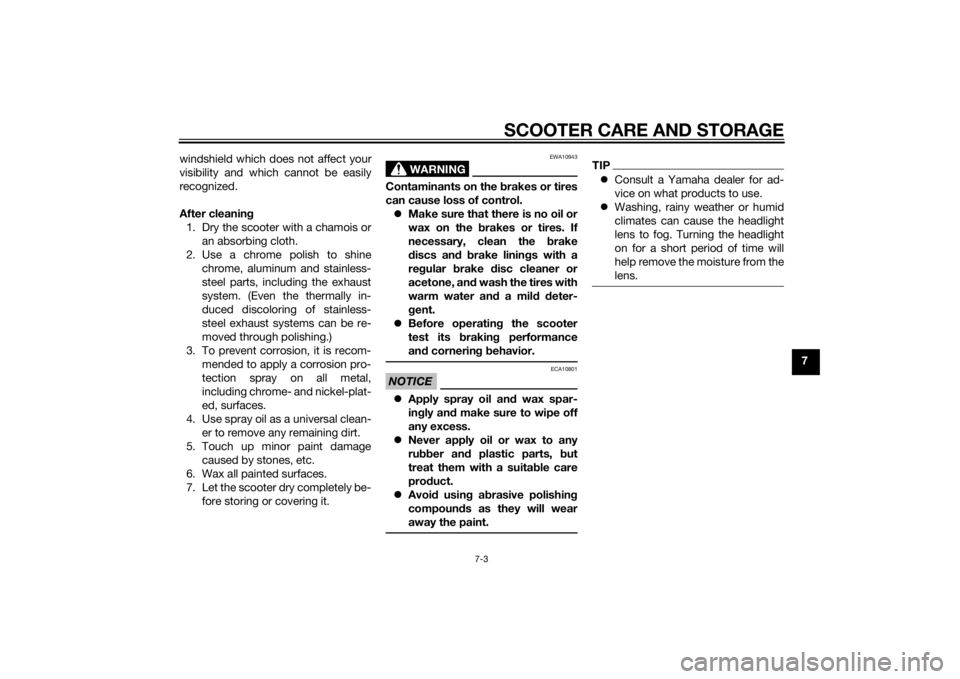warning light YAMAHA XMAX 400 2014 User Guide
[x] Cancel search | Manufacturer: YAMAHA, Model Year: 2014, Model line: XMAX 400, Model: YAMAHA XMAX 400 2014Pages: 92, PDF Size: 7.3 MB
Page 59 of 92

PERIODIC MAINTENANCE AND ADJUSTMENT
6-16
6
5. Remove the final transmission oil
drain bolt and its gasket to drain
the oil from the final transmission
case.
6. Install the final transmission oil
drain bolt and its new gasket, and
then tighten the bolt to the speci-
fied torque.
7. Refill with the specified amount of
the recommended final transmis-
sion oil. WARNING! Make surethat no foreign material enters
the final transmission case.
Make sure that no oil gets on
the tire or wheel.
[EWA11312]
8. Install the final transmission oil fill-
er cap and its new O-ring, and
then tighten the oil filler cap.
9. Check the final transmission case
for oil leakage. If oil is leaking,
check for the cause.
EAU20071
CoolantThe coolant level should be checked
before each ride. In addition, the cool-
ant must be changed at the intervals
specified in the periodic maintenance
and lubrication chart.
EAUM3043
To check the coolant level
1. Place the vehicle on a level surfa-
ce and hold it in an upright posi-
tion.
2. Open the front storage compart-
ment A. (See page 3-16.)TIPThe coolant level must be
checked on a cold engine since
the level varies with engine tem-
perature.
Make sure that the vehicle is posi-
tioned straight up when checking
the coolant level. A slight tilt to the
side can result in a false reading.3. Check the coolant level through
the check window.
1. Final transmission oil filler cap
2. O-ring
3. Final transmission oil drain bolt
4. GasketTightening torque:
Final transmission oil drain bolt:
20 Nm (2.0 m·kgf, 14 ft·lbf)
21
34
Recommended final transmission
oil:
See page 8-1.
Oil quantity:
0.25 L (0.26 US qt, 0.22 Imp.qt)
U1SDE1E0.book Page 16 Monday, September 23, 2013 3:55 PM
Page 74 of 92

PERIODIC MAINTENANCE AND ADJUSTMENT
6-31
6
EAUM3091
Replacing the fusesThe fuse box, which contains the fuses
for the individual circuits, is located be-
hind panel C. (See page 6-8.)TIPThe main fuse, which is in a different
and hard-to-reach location, must be
replaced by a Yamaha dealer.If a fuse for the individual circuits is
blown, replace it as follows.
1.
the electrical circuit in question.
2. Remove the blown fuse, and then
install a new fuse of the specified
amperage. WARNING! Do notuse a fuse of a higher amperage
rating than recommended to
avoid causing extensive dam-
age to the electrical system and
possibly a fire.
[EWA15132]
TIP
tool kit. Use the tongs to remove and
install a fuse.
YP400R
1. Main fuse
2. Spare main fuseZAUM1058
11
2
1. Fuse boxZAUM1036
1
1. Radiator fan fuse
2. ECU fuse
3. Backup fuse
4. Signaling system fuse
5. Headlight fuse
6. Ignition fuse
7. Spare fuse
8. Hazard fuseZAUM1037
7
1
2
3
4
5
620 10
1020
1010 1010
7.57.5
U1SDE1E0.book Page 31 Monday, September 23, 2013 3:55 PM
Page 78 of 92

PERIODIC MAINTENANCE AND ADJUSTMENT
6-35
6
EAU54501
Auxiliary lightThis model is equipped with LED-type
auxiliary lights.
If an auxiliary light does not come on,
have a Yamaha dealer check it.
EAU25882
TroubleshootingAlthough Yamaha scooters receive a
thorough inspection before shipment
from the factory, trouble may occur
during operation. Any problem in the
fuel, compression, or ignition systems,
for example, can cause poor starting
and loss of power.
The following troubleshooting charts
represent quick and easy procedures
for checking these vital systems your-
self. However, should your scooter re-
quire any repair, take it to a Yamaha
dealer, whose skilled technicians have
the necessary tools, experience, and
know-how to service the scooter prop-
erly.
Use only genuine Yamaha replace-
ment parts. Imitation parts may look
like Yamaha parts, but they are often
inferior, have a shorter service life and
can lead to expensive repair bills.
WARNING
EWA15142
When checking the fuel system, do
not smoke, and make sure there are
no open flames or sparks in the ar-
ea, including pilot lights from waterheaters or furnaces. Gasoline or
gasoline vapors can ignite or ex-
plode, causing severe injury or prop-
erty damage.
U1SDE1E0.book Page 35 Monday, September 23, 2013 3:55 PM
Page 83 of 92

SCOOTER CARE AND STORAGE
7-3
7 windshield which does not affect your
visibility and which cannot be easily
recognized.
After cleaning
1. Dry the scooter with a chamois or
an absorbing cloth.
2. Use a chrome polish to shine
chrome, aluminum and stainless-
steel parts, including the exhaust
system. (Even the thermally in-
duced discoloring of stainless-
steel exhaust systems can be re-
moved through polishing.)
3. To prevent corrosion, it is recom-
mended to apply a corrosion pro-
tection spray on all metal,
including chrome- and nickel-plat-
ed, surfaces.
4. Use spray oil as a universal clean-
er to remove any remaining dirt.
5. Touch up minor paint damage
caused by stones, etc.
6. Wax all painted surfaces.
7. Let the scooter dry completely be-
fore storing or covering it.
WARNING
EWA10943
Contaminants on the brakes or tires
can cause loss of control.
Make sure that there is no oil or
wax on the brakes or tires. If
necessary, clean the brake
discs and brake linings with a
regular brake disc cleaner or
acetone, and wash the tires with
warm water and a mild deter-
gent.
Before operating the scooter
test its braking performance
and cornering behavior.NOTICE
ECA10801
Apply spray oil and wax spar-
ingly and make sure to wipe off
any excess.
Never apply oil or wax to any
rubber and plastic parts, but
treat them with a suitable care
product.
Avoid using abrasive polishing
compounds as they will wear
away the paint.
TIPConsult a Yamaha dealer for ad-
vice on what products to use.
Washing, rainy weather or humid
climates can cause the headlight
lens to fog. Turning the headlight
on for a short period of time will
help remove the moisture from the
lens.
U1SDE1E0.book Page 3 Monday, September 23, 2013 3:55 PM
Page 87 of 92

SPECIFICATIONS
8-3
8
Voltage, capacity:
12 V, 8.0 AhHeadlight:Bulb type:
Halogen bulbBulb voltage, wattage × quantity:Headlight:
12 V, 55.0 W × 2
Tail/brake light:
LED
Front turn signal light:
12 V, 10.0 W × 2
Rear turn signal light:
12 V, 10.0 W × 2
Auxiliary light:
LED
License plate light:
12 V, 5.0 W × 1
Meter lighting:
12 V, 2.0 W × 3
High beam indicator light:
12 V, 1.4 W × 1
Turn signal indicator light:
12 V, 1.4 W × 2
Engine trouble warning light:
12 V, 1.4 W × 1
ABS warning light:
YP400RA 12 V, 1.4 W × 1
Immobilizer system indicator light:
LEDFuses:Main fuse:
30.0 AHeadlight fuse:
20.0 A
Signaling system fuse:
10.0 A
Ignition fuse:
10.0 A
Radiator fan fuse:
7.5 A
Hazard fuse:
10.0 A
ECU fuse:
10.0 A
ABS control unit fuse:
YP400RA 10.0 A
ABS motor fuse:
YP400RA 30.0 A
ABS solenoid fuse:
YP400RA 20.0 A
Backup fuse:
10.0 A
U1SDE1E0.book Page 3 Monday, September 23, 2013 3:55 PM
Page 89 of 92

10-1
10
INDEX
AABS (for ABS models) .......................... 3-12
ABS warning light (for ABS models) ....... 3-4
Acceleration and deceleration ................ 5-3
Air filter elements and check hoses
and V-belt case air filter element ....... 6-18
Anti-theft alarm (optional) ..................... 3-10
Auxiliary light ........................................ 6-35BBattery .................................................. 6-29
Brake fluid, changing............................ 6-26
Brake fluid level, checking.................... 6-24
Brake lever, front .................................. 3-11
Brake lever, rear ................................... 3-12
Brake levers, lubricating ....................... 6-27
Braking ................................................... 5-3CCables, checking and lubricating ......... 6-26
Care ........................................................ 7-1
Catalytic converters.............................. 3-15
Centerstand and sidestand, checking
and lubricating ................................... 6-27
Coolant ................................................. 6-16DDimmer switch...................................... 3-11EEngine break-in ...................................... 5-4
Engine oil and oil filter element............. 6-13
Engine trouble warning light ................... 3-4FFinal transmission oil ............................ 6-15
Front and rear brake lever free play,
checking ............................................. 6-23
Front and rear brake pads, checking ... 6-24Front fork, checking ............................. 6-28
Front turn signal light ........................... 6-33
Fuel ...................................................... 3-14
Fuel consumption, tips for reducing ...... 5-4
Fuel tank cap........................................ 3-13
Fuses, replacing ................................... 6-31
HHandlebar switches ............................. 3-10
Hazard switch ...................................... 3-11
Headlight bulb, replacing ..................... 6-32
High beam indicator light ....................... 3-4
Horn switch .......................................... 3-11IIdentification numbers ........................... 9-1
Ignition circuit cut-off system .............. 3-19
Immobilizer system ................................ 3-1
Immobilizer system indicator light ......... 3-4
Indicator lights and warning lights ......... 3-3LLicense plate light bulb, replacing ....... 6-34MMain switch/steering lock ...................... 3-2
Maintenance and lubrication, periodic... 6-4
Maintenance, emission control
system ................................................. 6-3
Matte color, caution ............................... 7-1
Model label............................................. 9-1
Multi-function display............................. 3-6PPanels, removing and installing ............. 6-8
Parking ................................................... 5-5
Part locations ......................................... 2-1
Pass switch .......................................... 3-11
SSafe-riding points ................................... 1-5
Safety information................................... 1-1
Seat....................................................... 3-16
Shock absorber assemblies,
adjusting ............................................. 3-18
Sidestand.............................................. 3-18
Spark plug, checking ............................ 6-11
Specifications ......................................... 8-1
Speedometer .......................................... 3-5
Starting off .............................................. 5-2
Starting the engine ................................. 5-1
Start switch ........................................... 3-11
Steering, checking ................................ 6-29
Storage ................................................... 7-4
Storage compartments ......................... 3-16TTachometer............................................. 3-6
Tail/brake light ...................................... 6-33
Throttle grip and cable, checking and
lubricating ........................................... 6-26
Throttle grip free play, checking ........... 6-20
Tires ...................................................... 6-21
Tool kit .................................................... 6-2
Troubleshooting .................................... 6-35
Troubleshooting charts ......................... 6-36
Turn signal indicator lights...................... 3-3
Turn signal light bulb (rear),
replacing ............................................. 6-33
Turn signal switch ................................. 3-11VValve clearance..................................... 6-20
Vehicle identification number ................. 9-1
U1SDE1E0.book Page 1 Monday, September 23, 2013 3:55 PM